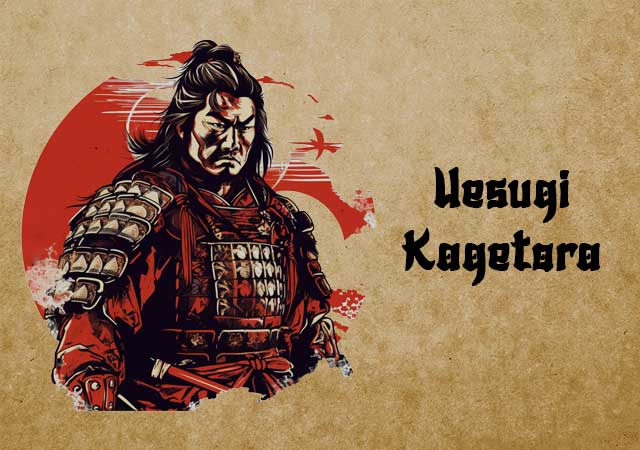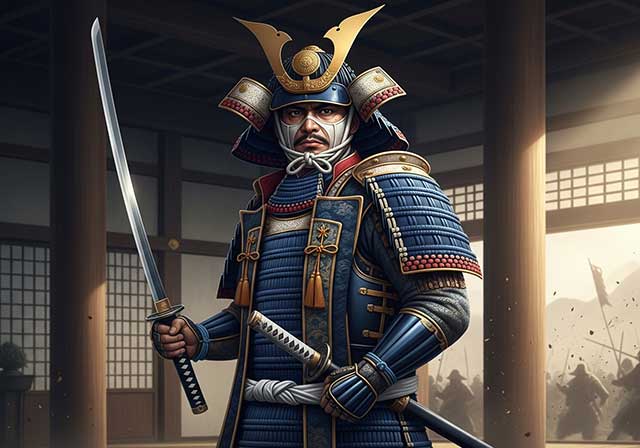
Uesugi Kagetora (1552 – April 19, 1579) was the seventh son of Hojo Ujiyasu and was originally known as Hojo Saburo. He was adopted by Uesugi Kenshin and intended to be Kenshin's heir. However, in 1578, he was attacked in his Otate Castle by Uesugi Kagekatsu, his brother-in-law, and was ultimately defeated. Kagetora committed suicide the following year at Samegao Castle.
Born in either 1552 or 1554, Kagetora was also known as Hojo Ujihide, Hojo Saburo, and Saburo Kagetora during his lifetime. He was the seventh son (the sixth to survive to adulthood) of Hojo Ujiyasu, and the brother of Hojo Ujimasa, Hojo Ujiteru, Hojo Ujikuni, Hojo Ujinori, Hojo Ujitada, and Hojo Ujimitsu. His mother was either the sister-in-law of Toyama Yasumitsu, a vassal of the Hojo clan, or Suikeiin, Ujiyasu's principal wife. Historians generally agree that Hojo Saburo and Hojo Ujihide were two different individuals, with Ujihide being the son of Hojo Tsunashige and residing in Edo, while Saburo lived in Echigo.
As a child, Kagetora was sent to the priesthood at Soun-ji in Hakone and later held hostage by Takeda Shingen of the Takeda clan as part of a three-way alliance between the Hojo, Takeda, and Imagawa clans formed in 1554. In 1569, he was adopted by his uncle Hojo Genan and married Genan's daughter.
In 1569, as part of an alliance between the Hojo and Uesugi clans, Saburo was sent to Uesugi Kenshin as a hostage. Initially, Hojo Ujimasa's third son Kunimasumaru was to be the hostage, but Ujimasa, unable to part with his baby son, sent Saburo instead. Kenshin, who never married, took a liking to the handsome and intelligent Saburo. Kenshin married his niece Seienin to Saburo, gave him the name Kagetora, and adopted him into the Uesugi clan.
When Kenshin died suddenly in 1578 without naming an heir, Kagetora and Kagekatsu, who had also been adopted by Kenshin, fought for succession in what became known as the Otate no Ran. Initially, Kagetora had the upper hand with support from Uesugi vassals and the Hojo clan, but the tide turned when Takeda Katsuyori betrayed him and sided with Kagekatsu.
After Otate Castle fell in 1579, Kagetora attempted to flee to Odawara Castle, the Hojo stronghold, but was betrayed at Samegao Castle by Horie Munechika and committed suicide. Seienin, his wife, also committed suicide, although some accounts suggest she did so at Otate when her brother Kagekatsu refused Kagetora's surrender. Kagetora's eldest son, Doumanmaru, was killed by Kagekatsu's troops along with Uesugi Norimasa, and the rest of Kagetora's children are believed to have died during the power struggle.
Kagetora was considered by some to be a better heir for Kenshin due to his intelligence and assistance in battles, while Kagekatsu was known for gaining support within the Uesugi clan.
A modern-day reincarnation of Kagetora appears in the light novel and anime series "Mirage of Blaze." In this series, he is one of the two primary characters, members of the Uesugi Netherworld Force, responsible for exorcising undead soldiers from the Japanese Feudal Era who are participating in a modern-day war led by reincarnations of various feudal era warlords, including the spirit of Takeda Shingen.
See also
-
Uemura Masakatsu

Masakatsu was a member of the Uemura clan and the son of Uemura Masatada; from an early age he served Tokugawa Ieyasu. During the Ikkō-ikki uprising in Mikawa Province in 1563, having converted from the Jōdo Shinshū Buddhist sect to the Jōdoshū sect, he took part in suppressing the rebels. After these events, Masakatsu was appointed a military governor and was granted land holdings. According to a number of sources, he was one of the so-called “Three Governors of Mikawa” (Mikawa sanbugyō), together with Amano Yasukage (1537–1613) and Koriki Kiyonaga (1530–1608).
-
Tomoe Gozen

Gozen is regarded as one of the few historically documented examples of true female warriors of feudal Japan, known as onna-musha or onna-bugeisha. Although Japanese history records countless women who at various times were forced to take up arms—for example, in defense of their castles—Tomoe Gozen was, without any doubt, a genuinely skilled and accomplished fighter. She was the wife of Kiso (Minamoto) Yoshinaka, although The Tale of the Heike describes her more as a female vassal. Yoshinaka rose in rebellion against the Taira clan and, in 1184, captured Kyoto after his victory at the Battle of Kurikawa. After the Taira were driven into the western provinces, Yoshinaka began insistently asserting that he alone was worthy of assuming leadership of the Minamoto clan and taking on the mantle of its head.
-
Tachibana Muneshige

Tachibana Muneshige was born the eldest son of Takahashi Shigetane, one of the principal retainers of the Ōtomo clan and commander of Iwaya Castle. In childhood, he bore the name Senkumamaru. His early years coincided with a period of intense military confrontation between the Ōtomo clan and other powerful warrior houses of Kyūshū—namely the Shimazu, Akizuki, and Ryūzōji clans.
-
Tachibana Dosetsu

Tachibana Dōsetsu is the name by which Hetsugi Akitsura is more widely known; the name of this lineage is also found read as Hekki or Bekki. For a long period, Akitsura served the Ōtomo clan, the daimyō of Bungo Province, and took part in wars against the Ōuchi family, the principal enemies of the Ōtomo in northwestern Kyushu. In the 1560s, Akitsura seized the castle of the Tachibana clan, which had rebelled against the Ōtomo, and thereafter adopted the surname Tachibana. Around the same time, he took Buddhist vows and assumed the name Dōsetsu, which means “Snowy Road.”
-
Taira no Masakado

Taira no Masakado embodied the quintessential samurai of his era—self-assured, harsh, and unyielding. In his youth, he served in the palace guard and repeatedly proved his bravery while suppressing unrest. Thanks to these achievements, Masakado sought the post of chief of the capital’s military-police office (the kebiishi-chō), but he was rejected: by that time, nearly all court positions—now little more than privileged sinecures—were controlled by members of the powerful Fujiwara clan.
-
Sakakibara Yasumasa

Yasumasa was the second son of Sakakibara Nagamasa and was born in Ueno in Mikawa Province. From a young age, he began serving Tokugawa Ieyasu and eventually rose to the position of one of his most trusted generals. His wife was the daughter of Osuga Yasutaka. Ieyasu first noticed the young Yasumasa during the suppression of the Ikkō-ikki uprising in Mikawa in 1564. Thanks to his demonstrated abilities, Yasumasa was granted the privilege of using the character “yasu”—the second character of Ieyasu’s own name—in his own. Although he was the second child in his family, he became his father’s heir, though the exact reasons for this remain unknown.
-
Sakai Tadatsugu

Tadatsugu was one of the most renowned generals serving Tokugawa Ieyasu. After Ieyasu broke ties with the Imagawa clan, Tadatsugu—an ardent supporter of this decision—was granted command of Yoshida Castle in 1565, which controlled the coastal road from Tōtomi to Mikawa. During the Battle of Mikatagahara in 1573, he held the right flank of the Tokugawa forces even when the troops sent by Oda fled under the assault of the Takeda army. In the Battle of Nagashino in 1575, he personally requested permission to carry out a night attack on the Takeda camp, which he executed brilliantly together with Kanamori Nagachika.
-
Ryuzoji Takanobu

Takanobu was the eldest son of Ryūzōji Takaie and the great-grandson of Ryūzōji Iekane. His father was killed by a man named Baba Yoritiku in 1544. At a young age, Takanobu took Buddhist vows and received the monastic name Engetsu. However, around the age of eighteen, he returned to secular life, and in 1548, after the death of Ryūzōji Tanehide, he became the head of both branches of the Ryūzōji family.

